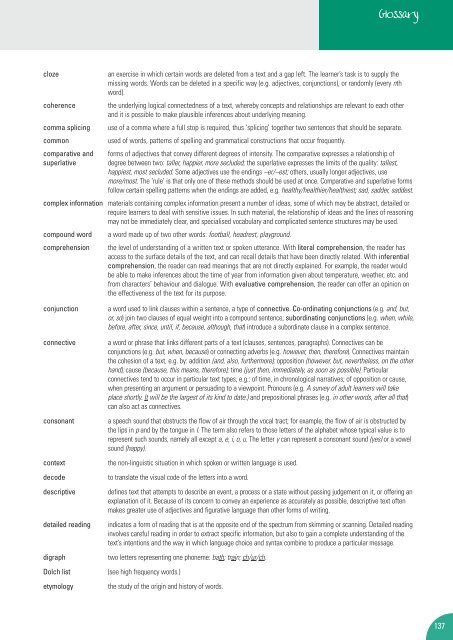Adult Literacy Core Curriculum - Nationally developed Skills for Life ...
Adult Literacy Core Curriculum - Nationally developed Skills for Life ...
Adult Literacy Core Curriculum - Nationally developed Skills for Life ...
Create successful ePaper yourself
Turn your PDF publications into a flip-book with our unique Google optimized e-Paper software.
Glossary<br />
cloze an exercise in which certain words are deleted from a text and a gap left. The learner’s task is to supply the<br />
missing words. Words can be deleted in a specific way (e.g. adjectives, conjunctions), or randomly (every nth<br />
word).<br />
coherence the underlying logical connectedness of a text, whereby concepts and relationships are relevant to each other<br />
and it is possible to make plausible inferences about underlying meaning.<br />
comma splicing use of a comma where a full stop is required, thus ‘splicing’ together two sentences that should be separate.<br />
common used of words, patterns of spelling and grammatical constructions that occur frequently.<br />
comparative and <strong>for</strong>ms of adjectives that convey different degrees of intensity. The comparative expresses a relationship of<br />
superlative degree between two: taller, happier, more secluded; the superlative expresses the limits of the quality: tallest,<br />
happiest, most secluded. Some adjectives use the endings –er/–est; others, usually longer adjectives, use<br />
more/most. The ‘rule’ is that only one of these methods should be used at once. Comparative and superlative <strong>for</strong>ms<br />
follow certain spelling patterns when the endings are added, e.g. healthy/healthier/healthiest; sad, sadder, saddest.<br />
complex in<strong>for</strong>mation materials containing complex in<strong>for</strong>mation present a number of ideas, some of which may be abstract, detailed or<br />
require learners to deal with sensitive issues. In such material, the relationship of ideas and the lines of reasoning<br />
may not be immediately clear, and specialised vocabulary and complicated sentence structures may be used.<br />
compound word a word made up of two other words: football, headrest, playground.<br />
comprehension the level of understanding of a written text or spoken utterance. With literal comprehension, the reader has<br />
access to the surface details of the text, and can recall details that have been directly related. With inferential<br />
comprehension, the reader can read meanings that are not directly explained. For example, the reader would<br />
be able to make inferences about the time of year from in<strong>for</strong>mation given about temperature, weather, etc. and<br />
from characters’ behaviour and dialogue. With evaluative comprehension, the reader can offer an opinion on<br />
the effectiveness of the text <strong>for</strong> its purpose.<br />
conjunction a word used to link clauses within a sentence, a type of connective. Co-ordinating conjunctions (e.g. and, but,<br />
or, so) join two clauses of equal weight into a compound sentence; subordinating conjunctions (e.g. when, while,<br />
be<strong>for</strong>e, after, since, until, if, because, although, that) introduce a subordinate clause in a complex sentence.<br />
connective a word or phrase that links different parts of a text (clauses, sentences, paragraphs). Connectives can be<br />
conjunctions (e.g. but, when, because) or connecting adverbs (e.g. however, then, there<strong>for</strong>e). Connectives maintain<br />
the cohesion of a text, e.g. by: addition (and, also, furthermore); opposition (however, but, nevertheless, on the other<br />
hand); cause (because, this means, there<strong>for</strong>e); time (just then, immediately, as soon as possible). Particular<br />
connectives tend to occur in particular text types, e.g.: of time, in chronological narratives; of opposition or cause,<br />
when presenting an argument or persuading to a viewpoint. Pronouns (e.g. A survey of adult learners will take<br />
place shortly. It will be the largest of its kind to date.) and prepositional phrases (e.g. in other words, after all that)<br />
can also act as connectives.<br />
consonant a speech sound that obstructs the flow of air through the vocal tract; <strong>for</strong> example, the flow of air is obstructed by<br />
the lips in p and by the tongue in l. The term also refers to those letters of the alphabet whose typical value is to<br />
represent such sounds, namely all except a, e, i, o, u. The letter y can represent a consonant sound (yes) or a vowel<br />
sound (happy).<br />
context the non-linguistic situation in which spoken or written language is used.<br />
decode to translate the visual code of the letters into a word.<br />
descriptive defines text that attempts to describe an event, a process or a state without passing judgement on it, or offering an<br />
explanation of it. Because of its concern to convey an experience as accurately as possible, descriptive text often<br />
makes greater use of adjectives and figurative language than other <strong>for</strong>ms of writing.<br />
detailed reading indicates a <strong>for</strong>m of reading that is at the opposite end of the spectrum from skimming or scanning. Detailed reading<br />
involves careful reading in order to extract specific in<strong>for</strong>mation, but also to gain a complete understanding of the<br />
text’s intentions and the way in which language choice and syntax combine to produce a particular message.<br />
digraph two letters representing one phoneme: bath; train; ch/ur/ch.<br />
Dolch list (see high frequency words.)<br />
etymology the study of the origin and history of words.<br />
137

















